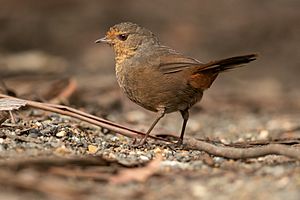Pilotbird facts for kids
Quick facts for kids Pilotbird |
|
|---|---|
 |
|
| Pilotbird, Blue Mountains | |
| Conservation status | |
| Scientific classification | |
| Genus: |
Pycnoptilus
|
| Species: |
floccosus
|
| Subspecies | |
|
|
The pilotbird (Pycnoptilus floccosus) is a small, special bird that lives only in south-eastern Australia. It belongs to a bird family called Acanthizidae. The pilotbird is the only species in its group, which is why scientists call it monotypic.
Contents
About the Pilotbird's Name
An English bird expert named John Gould first described the pilotbird in 1851. The name Pycnoptilus comes from old Greek words meaning 'thick feather'. Its other name, floccosus, is a Latin word that means 'flocked with wool'. This probably describes its soft, fluffy feathers.
There are two types of pilotbirds, called subspecies:
- The Pycnoptilus floccosus floccosus lives in high, cold mountain areas.
- The P. f. sandfordi lives in forests closer to sea level.
What Does the Pilotbird Look Like?
The pilotbird is a plump, medium-sized bird. It is about 18 centimeters (7 inches) long and weighs around 27 grams (1 ounce). That's about the weight of a few pencils!
Its feathers are reddish-brown on its belly. Its chest has a wavy pattern, and the middle of its belly has dull white spots. The feathers on its back are a rich chocolate-brown color. The pilotbird has a short, pointy beak. Its tail is wide and often held upright. It wiggles its tail up and down while it looks for food.
Where Do Pilotbirds Live?
Pilotbirds live in a specific part of south-eastern Australia. You can find them from the Wollemi National Park and Blue Mountains National Park in New South Wales. Their home also stretches down to the Dandenong Ranges, which are near Melbourne in Victoria.
They like to live in wet forests with lots of trees and thick plants on the ground. These forests are often called "wet sclerophyll forests." They also sometimes live in temperate rainforests. Pilotbirds stay in the same area all year round and are quite common where they live.
Pilotbird Habits and Calls
The pilotbird gets its name from a special habit. People used to think it followed lyrebirds. Lyrebirds are larger birds that dig around on the ground. The pilotbird would then eat the insects and other small creatures that the lyrebird uncovered. It was also thought that the pilotbird's call helped bushmen find lyrebirds. Even though this habit is famous, it's not seen very often.
Pilotbirds spend most of their time on or near the ground. They have strong legs and can run very fast if they feel in danger. Their call is described as "piercing and sweet." The male pilotbird makes a loud call that sounds like wit-wit-weet-WHEER. The female might answer with a softer wit-a-wit-ee.
Pilotbird Reproduction and Life Cycle
Pilotbirds usually breed between August and December. They build a round nest with an opening on the side. They hide their nest in piles of leaves, bark, and other natural debris on the forest floor. The nest is made from bark, ferns, dead leaves, and small roots.
A female pilotbird usually lays two eggs. Each egg is about 27 by 20 millimeters (1.1 by 0.8 inches). Their color can be grey-green or purple-brown. The female sits on the eggs for 20 to 22 days to keep them warm. This is called incubation.
Once the chicks hatch, they stay in the nest for 14 to 17 days. During this time, the male pilotbird often brings food to the female. He might also help take care of the baby birds, especially if the female is getting ready to lay more eggs. Sometimes, another bird called the fan-tailed cuckoo tries to lay its eggs in the pilotbird's nest. This is called brood parasitism.
Pilotbird Conservation
The pilotbird is quite common in the areas where it lives. However, its habitat has shrunk because of forests being cleared and cities growing. Luckily, much of its home is now protected in national parks or special reserves.
Climate change, bad weather, and bushfires are also threats to the pilotbird's home. But, experts last checked in 2016 and decided that the pilotbird is a species of "least concern" on the IUCN Red List. This means it is not currently in danger of disappearing.
Images for kids
See also
 In Spanish: Acantiza piloto para niños
In Spanish: Acantiza piloto para niños



